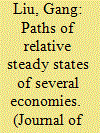|
|
|
Sort Order |
|
|
|
Items / Page
|
|
|
|
|
|
|
| Srl | Item |
| 1 |
ID:
186826


|
|
|
|
|
| Summary/Abstract |
Against the backdrop of socio-economic crisis and declining role of the state in infrastructure development, this article evaluates the inter-district disparities in social infrastructure (SI) and physical infrastructure (PI), and consequently attempts to examine the impact of SI and PI on economic growth in Punjab at two points in time, that is, 2004–2005 and 2016–2017. For this purpose, a district level social infrastructure index (SII) and a district level physical infrastructure index (PII) encapsulating 12 and 10 indicators, respectively, have been computed employing principal component analysis. The findings of the study revealed that PI acts as a pivotal catalyst to accelerate economic growth, whereas SI does not demonstrate any significant association with economic growth in Punjab. Furthermore, it is observed that pervasive inter-district disparities exist in SI and PI development and the majority of the districts depict a gloomy picture of infrastructure development in Punjab.
|
|
|
|
|
|
|
|
|
|
|
|
|
|
|
|
| 2 |
ID:
184143


|
|
|
|
|
| Summary/Abstract |
This article examines nalehmu, a set of informal relational practices for negotiating power across scales which have facilitated access and enforced accountability through mutually recognized norms and social sanctions in Myanmar. Like Asef Bayat’s “quiet encroachment” in the Middle East, nalehmu is Myanmar’s discreet and prolonged practice of agency that has enabled ordinary people to survive and better their lives despite the multiple ruptures in Myanmar’s history, as seen most recently in the February 2021 coup d’état. The paper analyzes how nalehmu serves as a hidden-in-plain-sight social infrastructure across three different scales: relations of mutuality, obligation, and reciprocity between individuals; implicit connections for accessing goods, services, and recognition; and a means of interacting with the state via the nalehmu economy. This analysis seeks to do more than add a different case to studies of urban Southeast Asia, but also to help produce further theorization that takes seriously the actually existing contexts and practices in the global South.
|
|
|
|
|
|
|
|
|
|
|
|
|
|
|
|
| 3 |
ID:
089973


|
|
|
|
|
| Publication |
2009.
|
| Summary/Abstract |
In this paper, an economy means a national economy; an economy's relative steady state means an economy's steady state of per-capita output relative to the mean of those of a broad set of economies. This paper provides a method used not only to get the path of an economy's relative steady state, but also to assess whether an economy's relative steady state changed between two given periods and whether an economy's relative steady state in a given period differed from another economy's in the same or a different given period. This paper also shows the paths of relative steady states of six economies (China, India, South Korea, Taiwan, Japan and USA) using the estimates of their relative steady states in four successive periods (1960s, 1970s, 1980s and 1990s). A comparison of the paths gives valuable information.
|
|
|
|
|
|
|
|
|
|
|
|
|
|
|
|
| 4 |
ID:
164714


|
|
|
|
|
| Summary/Abstract |
The existing literature on street vendors has largely examined processes of marginalisation of informal enterprises amid rapid urban development. At the same time, the resistance methods of street vendors against the constraints of urban development have been extensively explored. However, these studies tend to focus on the binary position between informal and formal, as well as on the overt confrontation and conflicts between vendors and the state, which risks simplifying the heterogeneity of interests in the everyday practice of street vending. Delving into the daily work of street vendors in Bandung city, this article explores the everyday practice of traders in order to identify their subtle forms of resistance to removal and to the negative perceptions attached to them. By adopting the analytics of ‘people as infrastructure’ (Simone, 2004) and the idea of ‘building blocks of success’ for small enterprises (Turner, 2003), this article argues that social infrastructure is constituted and practiced through the construction of personal relationships and varied forms of informal economic exchange between vendors and their customers, informal organisers and neighbours, as well as through the adoption of new technology. Social infrastructures have become a means of building everyday politics for street vendors and a vital way of challenging the negative perception attached to street vending activities.
|
|
|
|
|
|
|
|
|
|
|
|
|
|
|
|
|
|
|
|
|